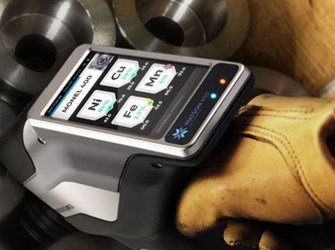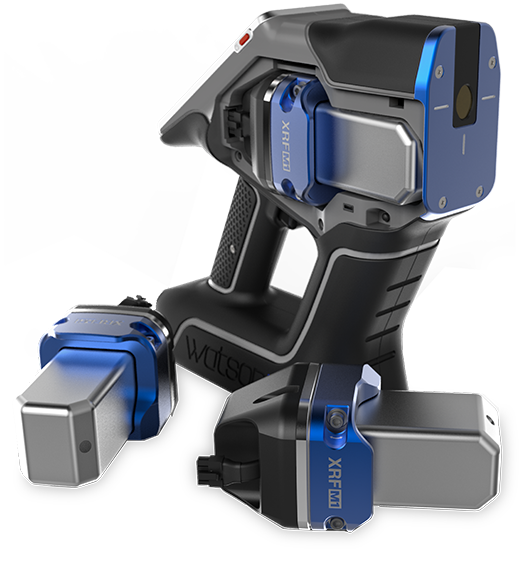X-Ray Technology In The Palm Of Your Hand
By Ed Biller

Traditional x-ray technology, using fragile vacuum tubes and hulking, high-voltage transformers, is expensive and generally immobile. But Los Angeles-based startup Tribogenics is seeking to create a new standard for X-ray by shrinking the technology into a portable package.
Development Challenges
In 2007, Carlos Camara was completing his Ph.D. at the University of California, Los Angeles (UCLA) when he and colleagues discovered the potential of triboluminescence — the generation of a charge imbalance through friction — as a tool. The effect had been a known phenomenon since the ancient Greeks, but Camara’s team was the first to harness it for diagnostic applications.
“I think triboluminescence was thought of more as a nuisance. There’s a whole industry whose sole focus is to eliminate the charging of surfaces, because it fries circuit boards and it causes fires,” Camara said in a recent interview with Med Device Online.
“What we did is try to determine the maximum amount of charge you could extract from the surfaces at the nanoscale, and we realized that it was a lot more than had previously been appreciated. So we developed the technology, and we patented the original intellectual property. I formed a company, and I negotiated with the university to get the exclusive rights to the invention.”
While Camara — now chief scientist at Tribogenics — maintains that the technology is “deceivingly simple,” development challenges arose from handling and manipulating the materials themselves.
“Our devices require us to bring surfaces into contact and then separate them, converting mechanical motion into high voltage. That’s the essence of our technology. But that task requires a very precise machine to accomplish. This was one of the challenges, to actually execute such a device in production,” he said.
However, one challenge with which Camara and his team did not have to contend was the use of radioisotopes. According to the World Nuclear Association, between 40 and 45 million medical procedures worldwide are performed annually using radioisotopes. About 90 percent of those procedures involve medical imaging.
“Radioisotopes are an alternative way of getting high voltage from a small volume. But, you can imagine all the challenges with radioisotopes. To name a few, you can’t turn them off and they are a security risk — you have to control them much more, since it’s a big risk for them to end up in the wrong hands,” said Camara. “One of our big advantages is that we can generate a high voltage X-ray source from a very small volume, and you can turn it on and off.”
Funding, Partnerships, And First Product Launch
A multitude of government and private parties have taken an interest in Tribogenics. The U.S. Defense Advanced Research Projects Agency (DARPA) funded the initial research at UCLA, but additional investments have come from Flywheel, the Founder’s Fund, and the U.S. Army Telemedicine & Advanced Technology Research Center (TATRC). TATRC invested specifically toward development of portable X-ray imaging for medical purposes.
In August, Tribogenics began nationwide shipping of its Watson XRF, a handheld tool that identifies materials by means of X-ray fluorescence. Camara compared Tribogenics’ first product to a cordless power tool: It is powered by a 24 V lithium ion battery, which the user simply charges at the end of the work day. Since users need different characteristic X-ray emissions for different applications, the instrument also features user-exchangeable X-ray sources.

Miniaturizing Medtech
Watson’s first applications include material identification in the manufacturing and recycling industries, as well as oil and gas production. Its performance in those fields will aid Tribogenics in its efforts to bring the technology to the medical field.
“The key thing for us, at this stage, is the fact that we have identified the first market where we’re going to validate our technology in a commercial setting,” said Camara.
“Other opportunities are there and, depending on the opportunity, we have varying degrees of partnerships and interest. We have an ongoing effort to demonstrate that the x-ray sources have an obvious application for medical imaging.”
In addition to providing x-ray capability in a portable package, Tribogenics’ technology has the potential to improve resolution for radiography, spectroscopy, and CT imaging.
“This is more speculative, but one of the exciting opportunities for us is that we can miniaturize the x-ray source to the point where you can envision building an array of small x-ray sources. Think of LEDs. Lighting solutions with LEDs are, in many cases, based on having many LEDs all shining together, as opposed to one big light bulb,” said Camara.
“That is very exciting in terms of an x-ray source, because all of a sudden you have an array of independently addressable x-ray sources that you can turn on and off as needed, in whatever pattern you might like. That is an increased capability for x-ray imaging. But it’s really hard to do that with the technology that is available today.”
In speaking about triboluminescence-driven medtech development, Camara returned to his analogy of LED lighting: Early LEDs produced little light and their role was well-served by conventional filament light bulbs. But, as the technology was refined and fitting applications were discovered, LEDs became the industry standard.
Likewise, as Watson XRF’s development progresses and Tribogenics’ ability to manipulate triboluminescence improves, medical imaging devices will become more feasible for the company.
“There are some partners that have been very, very interested in our technology for medical imaging, but they’re very risk-averse. They want to see the technology fully demonstrated,” said Camara.
Currently, Tribogenics is working with Los Alamos National Lab to develop a portable imaging solution, something that’s going to weigh about 10 pounds. But, for now, that initiative is not a front-burner project.
“That opportunity is still far away, and it’s a challenging market. We have to look at these efforts as a business opportunity as much as a technology development opportunity,” said Camara.
“The technical challenge of determining whether someone has a life-threatening medical condition by an x-ray picture, that’s generally a harder task than the x-ray fluorescence. We’ve lined up our opportunities in terms of the technical difficulty which, for us, translates into the amount of time that we have to spend developing that solution. We are walking before running.”
Still, Camara said he is excited about the prospect of making x-ray technology more accessible to more patients.
“As one of the inventors of this new technology, the potential to impact billions of people who don’t currently have access to x-ray diagnostics, not even for a dental procedure, is part of my motivation — to develop a technology to enable those solutions that could end up impacting billions of lives.”
The Road Ahead
At $9,999, the Watson XRF is the first handheld analyzer ever available for less than $10,000, and its spent x-ray source cartridges can be replaced for just $299 — just stuff it in an envelope and return it to the manufacturer to have a fresh cartridge sent.
According to Stewart Chalmers, head of marketing for Tribogenics, response to the Watson XRF has been overwhelmingly positive. “Our biggest problem right now is meeting the demand,” Chalmers said, adding that the company has no definitive timeline for introduction of its medical imaging technology.
Look for Tribogenics at MD&M East and West in 2016, where the company expects to present prototype and demo units of its technologies, according to Chalmers.
